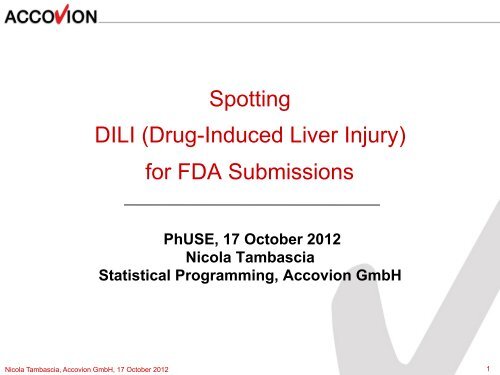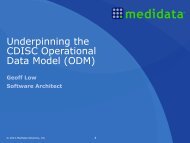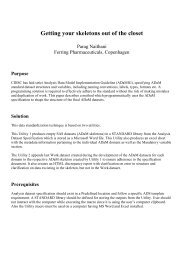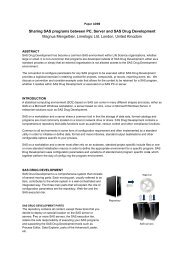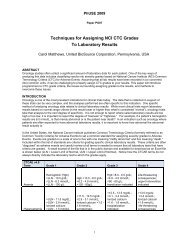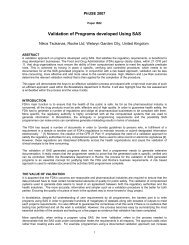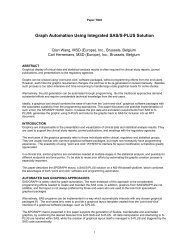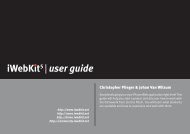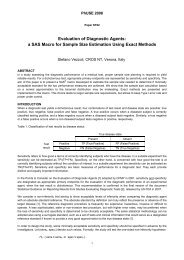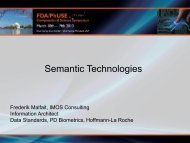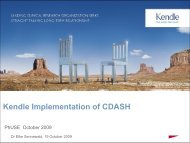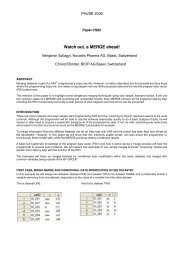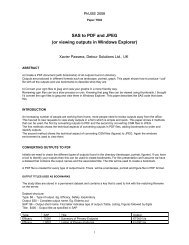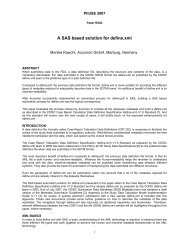Spotting DILI (Drug-Induced Liver Injury) for FDA ... - PhUSE Wiki
Spotting DILI (Drug-Induced Liver Injury) for FDA ... - PhUSE Wiki
Spotting DILI (Drug-Induced Liver Injury) for FDA ... - PhUSE Wiki
You also want an ePaper? Increase the reach of your titles
YUMPU automatically turns print PDFs into web optimized ePapers that Google loves.
<strong>Spotting</strong><br />
<strong>DILI</strong> (<strong>Drug</strong>-<strong>Induced</strong> <strong>Liver</strong> <strong>Injury</strong>)<br />
<strong>for</strong> <strong>FDA</strong> Submissions<br />
<strong>PhUSE</strong>, 17 October 2012<br />
Nicola Tambascia<br />
Statistical Programming, Accovion GmbH<br />
Nicola Tambascia, Accovion GmbH, 17 October 2012 1
Contents<br />
1. <strong>Drug</strong>-induced liver injury<br />
2. Hy’s Law<br />
3. eDISH – A tool <strong>for</strong> <strong>DILI</strong> evaluation<br />
4. <strong>DILI</strong> in an <strong>FDA</strong> submission<br />
5. References<br />
Nicola Tambascia, Accovion GmbH, 17 October 2012 2
<strong>Drug</strong>-induced liver injury<br />
What is <strong>DILI</strong><br />
" <strong>DILI</strong> = liver injury caused by a hepatotoxic drug<br />
" Severe <strong>DILI</strong> = death or transplant required<br />
Nicola Tambascia, Accovion GmbH, 17 October 2012 3
<strong>Drug</strong>-induced liver injury<br />
Why is <strong>DILI</strong> important<br />
„<strong>DILI</strong> has been the most frequent single cause of safetyrelated<br />
drug marketing withdrawals <strong>for</strong> the past 50 years<br />
(…), continuing to the present (…). [1]<br />
Nicola Tambascia, Accovion GmbH, 17 October 2012 4
<strong>Drug</strong>-induced liver injury<br />
<strong>Spotting</strong> <strong>DILI</strong> (1)<br />
" No specific findings<br />
" Seek alternative causes of liver injury<br />
Nicola Tambascia, Accovion GmbH, 17 October 2012 5
<strong>Drug</strong>-induced liver injury<br />
<strong>Spotting</strong> <strong>DILI</strong> (2)<br />
" Severe <strong>DILI</strong> is rarely seen even <strong>for</strong> significantly<br />
hepatotoxic drugs<br />
" Hepatotoxic drugs caused severe <strong>DILI</strong> in
Hy’s Law<br />
Major indicators of a potential <strong>for</strong> severe <strong>DILI</strong><br />
" Excess of ALT/AST elevations > 3*ULN<br />
" Marked elevations of ALT/AST to 5*, 10* or 20*ULN in<br />
modest numbers<br />
" One or more cases of Hy’s Law<br />
Nicola Tambascia, Accovion GmbH, 17 October 2012 7
Hy’s Law<br />
Definition of Hy’s Law<br />
" ALT/AST elevations ≥ 3*ULN more frequent than control<br />
" TBL elevations > 2*ULN<br />
" No alternative cause <strong>for</strong> ALT/AST/TBL elevations<br />
Nicola Tambascia, Accovion GmbH, 17 October 2012 8
Hy’s Law<br />
Hy’s Law and the submission database<br />
“worrisome”<br />
“highly predictive that<br />
the drug has the<br />
potential to cause<br />
severe <strong>DILI</strong>”<br />
" Two or more Hy’s Law cases: drug causes severe <strong>DILI</strong><br />
" Severe <strong>DILI</strong> at a rate ≥ 10% of Hy’s Law cases<br />
Nicola Tambascia, Accovion GmbH, 17 October 2012 9
eDISH – A tool <strong>for</strong> <strong>DILI</strong> evaluation<br />
Overview<br />
" eDISH = Evaluation of <strong>Drug</strong>-<strong>Induced</strong> Serious<br />
Hepatotoxicity<br />
" Created using SAS/Intrnet<br />
" Runs on CDISC data standard<br />
" Goal:<br />
1. Summarize subjects’ lab data<br />
2. Identify cases of interest<br />
3. Drill-down to individuals’ lab data over time<br />
Nicola Tambascia, Accovion GmbH, 17 October 2012 10
eDISH – A tool <strong>for</strong> <strong>DILI</strong> evaluation<br />
Hy’s Law<br />
Source of picture: [1], page 13<br />
Nicola Tambascia, Accovion GmbH, 17 October 2012 11
eDISH – A tool <strong>for</strong> <strong>DILI</strong> evaluation<br />
Source of picture: [1], page 14<br />
Nicola Tambascia, Accovion GmbH, 17 October 2012 12
<strong>DILI</strong> in an <strong>FDA</strong> submission<br />
Overview<br />
" No CDISC submission<br />
" <strong>DILI</strong> analysis as part of safety<br />
" Deliverables:<br />
• eDISH peak ALT/AST - peak TBL plot<br />
• Listing showing Lab-values over time<br />
• Patient narratives<br />
Click <strong>for</strong> example document<br />
Nicola Tambascia, Accovion GmbH, 17 October 2012 13
References<br />
(1) Guidance <strong>for</strong> Industry: <strong>Drug</strong>-<strong>Induced</strong> <strong>Liver</strong> <strong>Injury</strong>: Premarketing<br />
Clinical Evaluation<br />
http://www.fda.gov/downloads/<strong>Drug</strong>s/<br />
GuidanceComplianceRegulatoryIn<strong>for</strong>mation/Guidances/<br />
UCM174090.pdf<br />
(2) How a SAS/IntrNet tool was created at the <strong>FDA</strong> <strong>for</strong> the detection of<br />
potential drug-induced liver injury using data with CDISC standard<br />
(Ted Guo, John Senior, Kate Gelperin, U.S. <strong>FDA</strong>, Silver Spring, MD)<br />
http://www.lexjansen.com/wuss/2009/cdi/CDI-Guo.pdf<br />
Nicola Tambascia, Accovion GmbH, 17 October 2012 14
Thank you <strong>for</strong> your attention!<br />
Nicola Tambascia, Accovion GmbH, 17 October 2012 15


